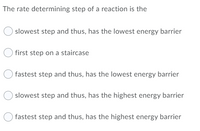
Chemistry
10th Edition
ISBN: 9781305957404
Author: Steven S. Zumdahl, Susan A. Zumdahl, Donald J. DeCoste
Publisher: Cengage Learning
expand_more
expand_more
format_list_bulleted
Question

Transcribed Image Text:The rate determining step of a reaction is the
slowest step and thus, has the lowest energy barrier
first step on a staircase
fastest step and thus, has the lowest energy barrier
slowest step and thus, has the highest energy barrier
fastest step and thus, has the highest energy barrier
Expert Solution
This question has been solved!
Explore an expertly crafted, step-by-step solution for a thorough understanding of key concepts.
Step by stepSolved in 3 steps with 3 images

Knowledge Booster
Similar questions
- :Draw two major product (stereoisomers) : Reaction type for the major product :Draw all the minor products (identify # of products) :Reaction type for the minor product(s)arrow_forwardA) + CH3-CH2-OH <--H+-->(equilibrium H+) D) + H2O what is the starting product in A and what is ending product in D.arrow_forwardWhich of the following is the rate-limiting step of a reaction? A) the fastest step in the reaction mechanism B) the slowest step in a reaction mechanism C) the last step in the reaction mechanism D) none of the abovearrow_forward
- Increasing the concentration of either of the reactants of an Sn2 reaction increases the rate of the reaction. The primary reason for this is that increasing the concentration increasesarrow_forwardWhich of the following energy diagrams is a reaction with one intermediate? ... reaction coordinate ... reaction coordinate free energy, kJ/mol free energy, kJ/molarrow_forwardThe question is attachedarrow_forward
- For lab 4, we combined baking soda with vinegar, according to the chemical equation NaHCO 3 + CH 3COOH ==== NaCH 3COO + CO 2 + H 2O Consider 3 experiments: (i) 2g baking soda + 5mL vinegar, (ii) 2g baking soda + 10mL vinegar and (iii) 2g baking soda + 20mL vinegar. The amount of CO 2 produced was highest for (iii) and lowest for (i). For these experiments, which of the following is true? Vinegar ran out first Baking soda ran out first They both ran out at the same time Neither ran outarrow_forwardDraw the arrows showing how electron move to get from reactant to product ?arrow_forwardCompound A is heated in methanol B to give product C. a. Draw product C and provide a detailed mechanism for its formation. OSO₂CH3 + CH3OH A A B Carrow_forward
- Compound A can be converted to either B or C. The energy diagrams for both processes are drawn on the graph below. a.) Label each reaction as endothermic or exothermic.b.) Which reaction is faster?c.) Which reaction generates the product lower in energy?d.) Which points on the graphs correspond to transition states?e.) Label the energy of activation for each reaction.d.) Label the ΔHo for each reaction.arrow_forwardConsider the reaction coordinate diagram shown. Which step has the greatest rate constant going in the forward direction? Free Energy O O A E going to F OC going to E E going to G OC going to A A going to C C D Progress of rxn E Farrow_forwardWhy does a higher concentration make a reaction faster?arrow_forward
arrow_back_ios
SEE MORE QUESTIONS
arrow_forward_ios
Recommended textbooks for you
 ChemistryChemistryISBN:9781305957404Author:Steven S. Zumdahl, Susan A. Zumdahl, Donald J. DeCostePublisher:Cengage Learning
ChemistryChemistryISBN:9781305957404Author:Steven S. Zumdahl, Susan A. Zumdahl, Donald J. DeCostePublisher:Cengage Learning ChemistryChemistryISBN:9781259911156Author:Raymond Chang Dr., Jason Overby ProfessorPublisher:McGraw-Hill Education
ChemistryChemistryISBN:9781259911156Author:Raymond Chang Dr., Jason Overby ProfessorPublisher:McGraw-Hill Education Principles of Instrumental AnalysisChemistryISBN:9781305577213Author:Douglas A. Skoog, F. James Holler, Stanley R. CrouchPublisher:Cengage Learning
Principles of Instrumental AnalysisChemistryISBN:9781305577213Author:Douglas A. Skoog, F. James Holler, Stanley R. CrouchPublisher:Cengage Learning Organic ChemistryChemistryISBN:9780078021558Author:Janice Gorzynski Smith Dr.Publisher:McGraw-Hill Education
Organic ChemistryChemistryISBN:9780078021558Author:Janice Gorzynski Smith Dr.Publisher:McGraw-Hill Education Chemistry: Principles and ReactionsChemistryISBN:9781305079373Author:William L. Masterton, Cecile N. HurleyPublisher:Cengage Learning
Chemistry: Principles and ReactionsChemistryISBN:9781305079373Author:William L. Masterton, Cecile N. HurleyPublisher:Cengage Learning Elementary Principles of Chemical Processes, Bind...ChemistryISBN:9781118431221Author:Richard M. Felder, Ronald W. Rousseau, Lisa G. BullardPublisher:WILEY
Elementary Principles of Chemical Processes, Bind...ChemistryISBN:9781118431221Author:Richard M. Felder, Ronald W. Rousseau, Lisa G. BullardPublisher:WILEY

Chemistry
Chemistry
ISBN:9781305957404
Author:Steven S. Zumdahl, Susan A. Zumdahl, Donald J. DeCoste
Publisher:Cengage Learning

Chemistry
Chemistry
ISBN:9781259911156
Author:Raymond Chang Dr., Jason Overby Professor
Publisher:McGraw-Hill Education

Principles of Instrumental Analysis
Chemistry
ISBN:9781305577213
Author:Douglas A. Skoog, F. James Holler, Stanley R. Crouch
Publisher:Cengage Learning

Organic Chemistry
Chemistry
ISBN:9780078021558
Author:Janice Gorzynski Smith Dr.
Publisher:McGraw-Hill Education

Chemistry: Principles and Reactions
Chemistry
ISBN:9781305079373
Author:William L. Masterton, Cecile N. Hurley
Publisher:Cengage Learning

Elementary Principles of Chemical Processes, Bind...
Chemistry
ISBN:9781118431221
Author:Richard M. Felder, Ronald W. Rousseau, Lisa G. Bullard
Publisher:WILEY